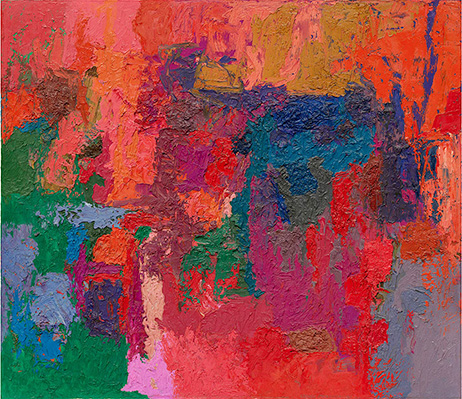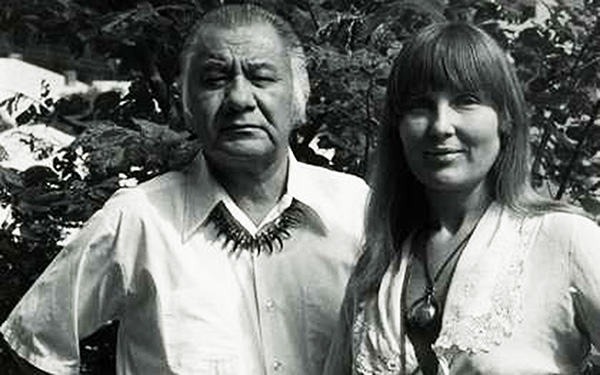조지 모리슨(George Morrison): DC 내셔널갤러리 구입 첫 인디언원주민 화가
조지 모리슨(George Morrision, 1919-2000)
뉴욕파에서 잊혀졌던 아메리칸 인디언 추상표현주의 화가

George Morrison, Untitled, 1961, oil on canvas, overall: 96.2 x 111.44 cm (37 7/8 x 43 7/8 in.), National Gallery of Art, Washington, Gift of Funds from David M. Rubenstein, 2022.123.1
잭슨 폴락, 윌렘 드 쿠닝, 프란츠 클라인 등 1950-60년대 뉴욕을 풍미했던 추상표현주의 화가들의 대부분은 백인 남성들이었다. #MeToo와 #BlackLivesMatter을 타고, 헬렌 프랭켄탈러, 조안 미첼, 리 크래스너 등 백인 여성작가들과 노만 루이스, 샘 길리엄, 에드워드 클락 등 흑인 작가들도 근래 새로이 조명되어왔다.
한편, 워싱턴 DC의 내셔널갤러리에선 최근 인디언원주민 추상표현주의 화가 조지 모리슨(George Morrision, 1919-2000)의 1961년 작 'Untitled'를 구입했다. 내셔널 갤러리가 구입한 첫 인디언아메리칸 화가의 작품이다.

George Morrison and Hazel Belvo, 1976. Photo: Victor Bloomfield, courtesy of the Minnesota Historical Society
미네소타주 그랜드포타지의 인디언 보호구역에서 태어난 조지 모리슨은 치페와족/ 오브지와족(Chippewa, Ojibwe, Ojibwa, Saulteaux- 미국과 캐나다에서 체로키족, 나바호족, 크릭족에 이어 네번째로 큰 인구) 출신으로 미네아폴리스미대 졸업 후 1943년부터 뉴욕의 아트스튜던트리그에서 수학한 후 추상표현주의 그룹에 가담해 윌렘 드 쿠닝, 프란츠 클라인, 잭슨 폴락, 필립 거스톤, 아돌프 고틀립과 교류했다. 1948년 맨해튼 그랜드센트럴모던에서 드 쿠닝과 함께 전시했으며, 휘트니뮤지엄 등지에서 개인전과 그룹전을 열었다.
모리슨은 1952년 풀브라이트 장학금을 받고 파리 에콜데보자르와 프로방스 액스마르세이유대학교에서 수학했다. 귀국 후 오하이오주 데이튼아트인스티튜트, 코넬대, 펜주립대, 아이오아주립대, 로드아일랜드디자인스쿨 등지에서 가르쳤다. 데이튼아트인스티튜트에서 만난 페미니스트 화가 헤이젤 벨보(Hazel Belvo)와 결혼했다. 이후 미네소타주 슈피리어 호수 인근의 땅을 구입해 레드록(Red Rock)으로 명명해 이곳에서 살며 작업했다. 1984년 캐슬맨병 진단을 받고, 2000년 4월 레드록에서 사망했다.

George Morrison stamps, 2022 Photo: USPS
2013년 미네소타미국미술관에서 피닉스 허드뮤지엄, 아메리칸인디언뮤지엄 등지로 이어지는 순회 회고전 'Modern Spirit: The Art of George Morrison'이 열리며, 모리슨의 작품은 재조명됐다. 2022년 4월 미우정국에서 모리슨의 작품이 담긴 포에버 우표 Sun and River (1949), Phenomena Against the Crimson: Lake Superior Landscape (1985), Lake Superior Landscape (1981), Spirit Path, New Day, Red Rock Variation: Lake Superior Landscape (1990), Untitled (1995)를 발행했다.
*휘트니뮤지엄의 흑인 거장들 <1> 잭슨 폴락 옆 에드 클락(Ed Clark)
*휘트니뮤지엄의 흑인 거장들 <2> 프란츠 클라인 옆 노만 루이스(Norman Lewis)
*휘트니뮤지엄의 흑인 거장들 <3> 혼자만의 방 제이콥 로렌스(Jacob Lawrence)
*2018 휴고보스상 수상 시몬 리 구겐하임 뮤지엄 전시, 2019
Acquisition: George Morrison George Morrison, "Untitled"
George Morrison (Grand Portage Band of Chippewa, 1919–2000) is perhaps best known for his brilliantly colored paintings of the late 1950s and 1960s, and his wood collages begun in the mid-1960s. The National Gallery of Art has acquired Morrison’s Untitled (1961), expanding its significant collection of abstract expressionist works by adding this key voice, and the first work by a Native American, to its New York School holdings.
Morrison made this painting at a time when he was in and out of New York City, between teaching positions at the Rhode Island School of Design (RISD) and a residency at the Dayton Art Institute. He had arrived in New York in 1943 to study at the Art Students League, working and exhibiting alongside fellow abstract expressionist painters including Franz Kline, Philip Guston, Adolph Gottlieb, and Willem de Kooning. Morrison showed with de Kooning in 1948 at Grand Central Moderns, going on to have 15 solo and group exhibitions at galleries and museums, including the Whitney Museum of American Art.
The topographic effect in Untitled was created by squeezing oil paint directly onto the canvas from the tube. The painting characterizes Morrison’s mature abstractions from the early 1960s, works that are highly prized for their ability to straddle the concerns of the New York School while also presenting a Native worldview. Featuring saturated colors in variations of red, green, ocher, and blue, Untitled is organized in three sections that evoke the Anishinaabe cosmos of sky, land, and water. Echoes of the top register reappear in the bottom, as a glowing sunset would reflect on Lake Superior, near where the artist grew up and to which he returned at the end of his life. The mosaic of colored forms in Morrison’s abstract paintings from the 1960s and their structural reference to a horizon line would come to define his contribution to abstract expressionism.
Morrison was born in 1919 in Chippewa City, Minnesota, near Grand Marais on the North Shore of Lake Superior. He spoke his Native language until age nine, when he attended the Hayward Indian School, a boarding school run by the Bureau of Indian Affairs in Wisconsin. After working for the Depression-era Works Progress Administration in high school, Morrison attended the Minneapolis School of Art (now Minneapolis College of Art and Design). He was then awarded a Van Derlip Traveling Scholarship in 1943, which enabled him to move to New York City. As a Fulbright scholar from 1952 to 1953, he studied at the École des Beaux-Arts in Paris and the Université d’Aix-Marseilles in Aix-en-Provence, producing abstract art that combined expressionism, cubism, and surrealism. Beginning in the late 1950s, Morrison taught painting at several American universities, including Cornell University, Penn State, and RISD. He returned to Minnesota in 1970 and taught studio art and American Indian studies at the University of Minnesota until his retirement from teaching in 1983. Morrison continued to work for 17 years from his home and studio, which he called Red Rock, at Grand Portage on the Grand Portage Indian Reservation, until his death in 2000. Morrison has been the subject of many group exhibitions as well as a recent monographic traveling exhibition organized by the Minnesota Museum of American Art, in cooperation with the Plains Art Museum.





 아만다 김 감독 다큐멘터리 '백남준: 달은 가장 오래된 TV' 필름...
아만다 김 감독 다큐멘터리 '백남준: 달은 가장 오래된 TV' 필름...

